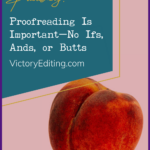A clever play on words can draw attention in a good way, but you don’t want anything to detract from your story. And nothing can yank a discerning reader out of a book quicker than heaving beasts or the flow of hair through fabric.
If you prefer to listen to this article, click the audio player below.
But before we talk about proofreading—let’s define it, shall we? Because editing terms can be subjective, and if you ask five different editors what they mean by line editing, developmental editing, proofreading, etc., you’re likely to get five different answers. The best piece of advice I can give to authors looking to build their production team is this: don’t just shop for proofreading (or line editing, or any other service) without making sure you know exactly what the editor is going to provide. You’ll find some editors, like at Victory Editing, do what’s closer to a copy edit when they proofread. Others may only look for typos. Always make sure you’re on the same page. So here’s a quick rundown of the most widely accepted definitions:
- Developmental Editing (also sometimes called story editing, content editing, or substantive editing): Big-picture issues like pacing, story arc, and character development.
- Line Editing: Polishing the writing, looking at stylistic issues such as showing vs. telling, dialogue, overuse of adjectives, adverbs, etc., sequencing of action, tense issues, point of view, continuity, optimizing scene and chapter endings.
- Copy Editing: Going over grammar, punctuation, usage, spelling, brand name verification, minor fact checking, continuity, etc. Making sure the manuscript is compliant with the style guide of choice (usually Chicago Manual of Style in America, the New Oxford Style Manual for the UK). Often combined with line editing.
- Proofreading: Checks for purely grammatical issues such as spelling, usage, punctuation, and so forth. Some editors may lean more toward copyediting in this stage, so make sure you ask what you’re getting.
- Final Pass / Cold Read: This is what I call Oops Detection® at Victory Editing, and it’s a final check to look for any lingering typos or editing artifacts.
Something to be aware of is that you may see “proofreading” services that range anywhere from the copyediting phase I listed above all the way down to the final pass stage, so it’s vitally important to make sure you and your editor are talking about the same scope of service.
Okay—now you have a good idea of what I mean when I talk about proofreading. But that doesn’t answer the question of why you need it, even if you got your book edited. The answer to that is twofold. First, it’s impossible for one person to catch every little thing in a manuscript. Second, it’s vitally important to have fresh eyes on your manuscript. Lastly, keep in mind that if the editing you got was developmental, there’s a high likelihood that your manuscript has changed substantially since then. A lot of editors don’t even bother looking at grammatical issues during the developmental stage—they fully expect the story to get torn down and rebuilt, and there’s no point in painting the walls in the kitchen when you’re about to pull all the cabinets out.
So, the first point is that one person isn’t going to catch everything, especially not in one pass. If your editor is focusing on polishing the language of the story, it’s quite possible that they’ll miss something in the next sentence. It happens. Most editors do make multiple passes, but eventually the brain starts lying to you, whether you’re self-editing your own manuscript before sending it to the editor or you’re the editor doing a project for hire. You’ve looked at a passage so many times that your brain starts whispering evil things like: “It’s right. You know it’s right. Everything’s just the way it’s supposed to be!” It’s the visual equivalent of when your friend tells you the same story the tenth time—you just smile and nod along, and the words are going in one ear and out the other. Let’s say your editor made five thousand revisions. Even if they caught 90 percent of the errors in the manuscript… you do the math on that.
I always recommend to my clients to get as many editing passes as their budget and publishing schedule will allow. It’s also important for those editing passes to be made by separate people. A lot of editors offer “combo packages,” but that really isn’t the best bang for your buck, with the one exception being to combine line editing with copyediting.
I know we tend to think of our books as our babies, and in some ways they are. They’re definitely a labor of love. But they’re also a product, and they reflect on your brand name. You don’t want your brand to be like that company that ships out some-assembly-required furniture and people are always griping on Amazon that parts were missing. You want readers to know that if they buy one of your books, they can expect a great reading experience with no distractions. And that means getting a proofreading pass, no ifs, ands, or buttsbuts.


